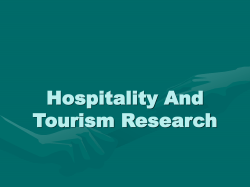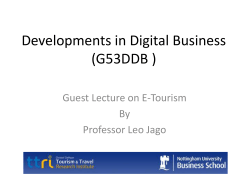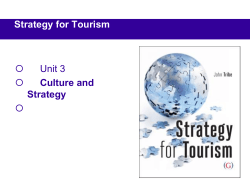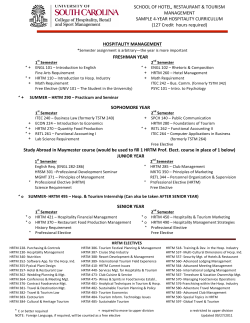
Tourism Information Technology 2 Edition
CABI TOURISM TEXTS 2nd Edition Tourism Information Technology PIERRE J. BENCKENDORFF PAULINE J. SHELDON DANIEL R. FESENMAIER COMPLIMENTARY TEACHING MATERIALS CABI TOURISM TEXTS Chapter 5 Social Media and Tourism CABI TOURISM TEXTS Chapter 5 Learning Objectives After studying this chapter you should be able to: 1. understand the types and functions of social media; 2. explain why electronic word of mouth is important to travel organizations; 3. analyze the advantages and disadvantages of different social media platforms; 4. discuss how different social media platforms can be used to engage with travelers; and 5. Adopt a strategic approach to using social media for a range of applications in travel organizations. CABI TOURISM TEXTS Key Concepts User-generated content (UGC) Electronic Word of Mouth (eWOM) Social network sites (SNSs) Blogs, wikis and product review sites Forums and discussion boards Media sharing Crowdsourcing Virtual worlds 4 Blogs Social networking Virtual social worlds Collaborative platforms Content sharing Virtual gaming worlds Low High Self Presentation/Disclosure CABI TOURISM TEXTS Low Medium Social Presence/Media Richness High FIGURE 5.1 Classification of social media. Adapted from: Kaplan & Haenlein, 2010 5 CABI TOURISM TEXTS FIGURE 5.2 The social media landscape. Source: Cavazza, 2012 6 CABI TOURISM TEXTS Western and Chinese Social Media Platforms Platform Western Examples Chinese Examples Blogs Blogger, Wordpress Blogbus Microblogs Twitter Sina Weibo, Tencent Weibo Wikis Wikipedia Baidu Baike Social Networks Facebook Qzone, Renren, Pengyou Video Sharing Youtube Youku, Tudou Location-based Foursquare Jiepang Review Sites TripAdvisor DaoDao 7 CABI TOURISM TEXTS PRESENCE SHARING The extent to which users exchange, distribute & receive content The extent to which users know if others are available IDENTITY The extent to which users reveal themselves CONVERSATIONS The extent to which users communicate with each other GROUPS The extent to which users are ordered or form communities RELATIONSHIPS The extent to which users relate to each other REPUTATION The extent to which users know the social standing of others & content FIGURE 5.3 The seven functional blocks of social media. Adapted from: Kietzmann et al., 2011 8 CABI TOURISM TEXTS Characteristics of eWOM eWOM differs from traditional WOM in the following ways: Scale Relationships Anonymity Durability Variety 9 Communication Scope One-to-one | One-to-many | Many-to-many CABI TOURISM TEXTS Virtual social worlds Blogs & wikis Media sharing Websites & review sites Email Social networks Chatrooms & forums Instant messaging Level of Interactivity Asynchronous Synchronous FIGURE 5.4 Typology of various eWOM channels. (Source: Litvin et al., 2008) 10 CABI TOURISM TEXTS SENDER Motives Appearance Credibility Expertise RECEIVER Characteristics Experience Cognition Response RELATIONSHIP Tie strength Homophily Trust FIGURE 5.5 Communication factors influencing eWOM. 11 CABI TOURISM TEXTS Social Media Platforms in Tourism Social network sites Wikis, blogs and product review sites Forums Media sharing Crowdsourcing Virtual worlds 12 CABI TOURISM TEXTS Social Network Sites Social network sites (SNSs) are defined as “web-based services that allow individuals to: construct a public or semi-public profile within a bounded system; articulate a list of other users with whom they share a connection; and view and traverse their connections and those made by others within the system.” (boyd and Ellison, 2007) Types of SNSs: Universal Professional Regional Niche 13 CABI TOURISM TEXTS Wikis, blogs and product review sites Definitions Wiki: is a real-time editable website that helps users create content through cooperative development and ownership (Bean & Hott, 2005) Blog: a personal website or web page which allows an individual to present content and opinions Product review site: a website devoted to providing subjective consumer feedback on products and services 14 CABI TOURISM TEXTS Wikis, blogs and product review sites Types of Blogs Traditional blogs Microblogs Multi-author blogs Video blogs Curated blogs 15 CABI TOURISM TEXTS Other Social Media Platforms Forums: a website where members can post comments and respond to posts from others Media sharing: platforms that allow users to to share, rate and leave comments about visual content Crowdsourcing: using the Internet to “find people to perform tasks that computers are generally lousy at” (Howe, 2006, p. 5) Virtual worlds: three-dimensional, computerbased simulated environments through which users can interact using avatars 16 CABI TOURISM TEXTS FIGURE 5.6 Strategic social media framework. Source: Advanced Human Technologies, 2013 17 CABI TOURISM TEXTS Strategic Applications of Social Media Marketing & sales Partnerships Recruitment Market intelligence Public relations 18 CABI TOURISM TEXTS Strategic use of different media Strategy Exposure Objective Generate awareness Media Traditional media, blogs, microblogs, media sharing Engagement Connect with travelers Social network sites, microblogs, forums Influence Change attitudes Social network sites, blogs, media sharing, reviews Acquisition Facilitate bookings Website, booking engine 19 CABI TOURISM TEXTS Discussion Questions 1. What features of social media make them different to other media? Provide some examples to illustrate your answer. 2. China has a number of parallel social media platforms that serve the same purpose as mainstream social media in the Western world. What are the implications of this? If you were working for a destination keen to attract the Chinese market, how could you harness the potential of these sites? 3. Brainstorm as many examples of social media as you can and write these down in a list. Use Cavazza’s (2012) Social Media Landscape model to categorize each of the examples you have listed. Which of these platforms do you use the most? Why? 4. Use the honeycomb model to map out the key strengths of SNSs, blogs, wikis, product review sites and media-sharing sites you are familiar with. 20 CABI TOURISM TEXTS Discussion Questions 5. Form a group with 4-5 other students and create a list of different ways in which you have used electronic Word-of-Mouth (eWOM) to find out about places and destinations. Compare your group’s answers with the rest of your class. What are the advantages and disadvantages of the eWOM information sources you have identified for (a) travelers and (b) travel organizations? 6. Visit TripAdvisor and search for five-star hotels in London that would be suitable for a business trip. Read some of the reviews for these hotels and summarize the most common positive and negative themes. Do you think any of the reviews are fake? Take a look at some of the images that accompany the reviews. Observe whether management has responded to some of these reviews. If you were the GM of a hotel, how would you respond to some of the negative themes you have identified? What strategies would you use to deal with fake reviews? How would you encourage positive reviews? 7. What is your opinion about the role of virtual worlds in travel? Do you think they offer a supplement or substitute for real travel experiences? How can travel companies use a virtual presence to enhance their reputation? 21 CABI TOURISM TEXTS Useful Websites TripAdvisor www.tripavisor.com National Geographic Intelligent Travel intelligenttravel.nationalgeographic.com Travelpod www.travelpod.com LonelyPlanet’s Thorn Tree www.lonelyplanet.com/thorntree WikiTravel.com www.wikitravel.org SecondLife www.secondlife.com 22 CABI TOURISM TEXTS Case Study The Best Job in the World In 2009 CumminsNitro were employed to run a campaign to raise international awareness of Australia’s Great Barrier Reef islands. “The Best Job in the World” – six months as the “caretaker” of Hamilton Island. The campaign: Video entries from 35,000 contestants in 200 countries 50 shortlisted contestants 16 finalists flown to Australia Myspace, Facebook, YouTube, Twitter and blogs allowed fans and followers to engage with the competition and its contestants. Campaign website attracted over 8 million unique visits and the contestant videos generated over 600 hours of content on YouTube. The $1.2 million investment generated over $160 million 23 in global publicity.
© Copyright 2025











